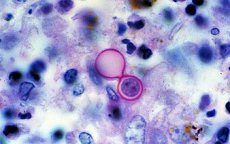The causative agent of blastomycosis
Last reviewed: 23.04.2024

All iLive content is medically reviewed or fact checked to ensure as much factual accuracy as possible.
We have strict sourcing guidelines and only link to reputable media sites, academic research institutions and, whenever possible, medically peer reviewed studies. Note that the numbers in parentheses ([1], [2], etc.) are clickable links to these studies.
If you feel that any of our content is inaccurate, out-of-date, or otherwise questionable, please select it and press Ctrl + Enter.

Morphology of Blastomyces dermatitis
Blastomyces dermatitis is a biphasic fungus. The mycelial phase is formed at 22-30 ° C, the mycelium is branching, septate, transverse, about 3 μm in size. Microconidia rounded, oval or pear-shaped, 2x10 μm in size, attached to lateral conidiophores. In a large number, hummocky chlamydospores resemble the macroconidia of N. Capsulatum and N. Duboisii. At 37 ° C and in the affected organism, the fungus is represented by a yeast phase. Yeast cells are large (10-20 microns), multinucleated, carrying single kidneys attached to the mother cell by a wide base.
Cultural properties of Blastomyces dermatitis
It is unpretentious to a nutrient substrate. At 25 ° C it grows with the formation of hyaline (non-pygmypted) hyphae with septa and round or pear-shaped conidia, and at 37 ° C forms large thick-walled yeast cells with kidneys that are connected to the parent cell by a wide base.
Biochemical activity is low.
 [1], [2], [3], [4], [5], [6], [7]
[1], [2], [3], [4], [5], [6], [7]
Antigenic structure of Blastomyces dermatitis
When growing on a liquid medium for 3 days, the mycedial form produces exoantigen A, which can be determined by immunodiffusion in a gel and ELISA. For the yeast phase, antigens A and B are described.
 [8], [9], [10], [11], [12], [13]
[8], [9], [10], [11], [12], [13]
Pathogenicity factors
Microconidia.
Ecological niche of Blastomyces dermatitis
Soil endemic zones covering the USA (southern and southern central states), Canada (Great Lakes region), South America and Africa.
 [14], [15], [16], [17], [18], [19],
[14], [15], [16], [17], [18], [19],
Sustainability in the environment
In the soil it is not very stable.
Sensitivity to antibiotics
Sensitive to amphotericin B and ketoconazole.
Sensitivity to antiseptics and disinfectants
Sensitive to the action of commonly used antiseptics and disinfectants.
Pathogenesis of blastomycosis
Microconidia enter the lungs, where the primary foci of inflammation develop. Microconidia are transformed into large-sized yeast cells. When forming a granuloma, areas of suppuration and necrosis, adjacent to intact tissues, are identified. Expressed processes of alteration predetermine the massiveness of the fungal secretion with pathological material. There are cases of primary blastomycosis of the skin that developed after an injury. The development of mycosis is promoted by diabetes mellitus, tuberculosis, hemoblasts, immunosuppressive states; In such individuals, blastomycosis shows a tendency to dissemination. The disseminated (systemic) form of the disease can develop several years after the primary pulmonary lesion. Any organ can be extracted into the pathological process, but the skin, bones, organs of the male genitourinary system, adrenals are more often affected .
Immunity cellular
The tension and duration of it have not been studied.
Epidemiology of blastomycosis
The source of the causative agent of infection is the soil of endemic zones. Diseases of hunting dogs confirm the idea of the presence of the same sources of pathogen for humans and animals. The transmission mechanism is aerogenic, the transmission path is air-dust. The massive ingestion of yeast cells leads to the introduction of an agent through the mucous membranes. The susceptibility of the population is universal, the sick are not contagious to others. The low incidence is due to the small size of the vegetation areas of the fungus, which minimizes the risk of infection.
Symptoms of blastomycosis
The incubation period ranges from several weeks to 4 months. The disease can begin as a respiratory infection with minimal symptoms or is acute and accompanied by a sudden increase in temperature, a cough with the release of purulent sputum, myalgia and arthralgia. Pneumonia often ends within 6-8 weeks without treatment. Later, a number of such patients develop mycosis. Common pneumonia often leads to the death of the patient, despite timely treatment.
In the cutaneous form of the disease, primary foci are represented by nodules from which ulcers form. The sites of ulceration with purulent discharge alternate with the zones of scarring. Ulcerous lesions can cover the mucous membrane of the oral cavity, spreading to the pharynx and larynx.
Laboratory diagnosis of blastomycosis
The test material is pus from fistulas and abscesses, cerebrospinal fluid, sputum, urine, punctate lymph nodes.
The most commonly used microscopic examination of pathological material. In a native preparation, clarified, one finds round or oval large yeast to the cells with a two-contour cell wall, which form a single lobe with a wide base.
To isolate the pure culture, the test material is sown on Saburo's medium, sugar agar, beer wort. The cultures are incubated at 37 ° C to produce yeast cells and at 25-30 ° C to obtain the initial phase. Transformation of yeast cells into the mycelium is achieved by lowering the growing temperature to 25-30 ° C. The characteristic morphological elements of the mycelial phase are observed for 2-3 weeks of incubation. In smears from the culture of the fungus, a capsule is found, a wide septate mycelium with thick walls. Conidia round, oval or pyriform. In old cultures, chlamydospores are formed.
Bioprobo is placed on white mice with subsequent sowing of affected tissue to nutrient media.
For serological diagnostics apply RSK, ELISA, RIA. Complement-binding antibodies in sufficient titers are detected in the late stages of the disease.
Intradermal allergic tests are put with an allergen blastomycin.

